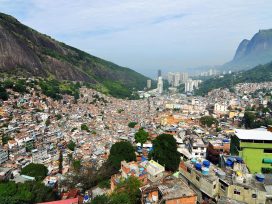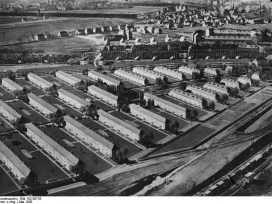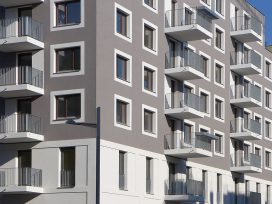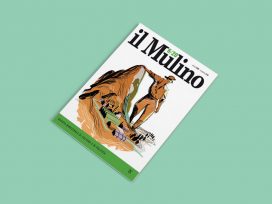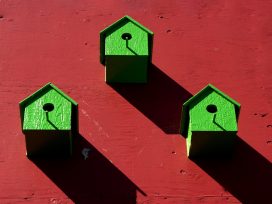Beirut is mad but the madness is balanced. Beirut is chaotic but the chaos is beautiful. Diverse in all perspectives: social, architectural, religious, political, economic, even archeological, Beirut is an intense patchwork of a city. In this overwhelming multiplicity there is a large public space that for many centuries functioned as the city’s heart and is now vast, central and vacant. How this is possible in a crowded, dense and noisy urban-scape, one can only guess.
Was it a miracle, fate, or political will?
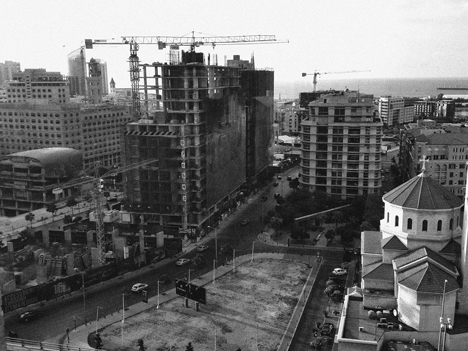
Martyr’s Square, Beirut. Photo: Lara Fakhri.
Today the private sector is the main player in Lebanon’s economy and the main drive behind the country’s dynamism and life-force. Remains of a generosity to the public sector can still be found in the physical presence of some major public spaces in the capital, among them Horsh Beirut and Martyrs’ Square. Yet despite a terrible lack of gathering spaces these two squares are somehow absent in the mind of Beirutis and therefore remain unused.
As for the Horsh Beirut, commonly known as Parc des Pins, the park has been deliberately made unavailable to the population, one needs a permit to access the park. On the other hand, Martyr’s Square is accessible to the public but from an urban perspective it is just another traveller’s void in the city, functioning only as a crossing point. The square that used to be the busiest in Beirut has been turned into a no-man’s-land.
There is no logic that can be superimposed on the city; people make it and it is to them, not buildings, that we must fit our plans.
Jane Jacobs, Downtown is For People
Martyr Square has a complex history echoed by the multitude of names given to it during different eras: Fakhreddine Gardens, Place des Canons, Sahat el Bourj. This square was once our ambassador to the world. In good times and in bad times, when dreamy postcards of a flourishing place on the Mediterranean Sea transformed into images of horror, destruction and war.
Martyrs’ Square somehow seems to be the thermometer for Lebanon, capturing the spirit of our country in different times. Its multifaceted life came about much long ago. In the seventeenth century a Tuscan palace was built with a tower on the east side of the Mediterranean called Fakhreddine. This tower was the reason the square was commonly known as Sahat Al Bourj, or Tower Square. Fundamentally this square was the core of the old town of Beirut and was surrounded by a wall with three of the main gates of the city opening into it. The name Sahat Al Bourj was kept until the breakout of the civil war in 1975.
During the glory days before the war Martyrs’ Square had developed into a civic space for a modern city. At the time it had all the ingredients needed to be a successful public area: streets, sidewalks, greenery, public transport, cultural and entertainment buildings. Then the civil war, or what the Lebanese journalist Ghassan Tueni named “a war for the others”, struck the country and in particular the capital (Tueni’s statement refers rightfully to the fact that the civil war was a war fought by other nationalities on Lebanese land: Palestinians fleeing their country, Syrians that received the green light from Lebanese parties to enter the country and, last but not least, is the Israeli bombing and invasion of southern Lebanon). Martyrs’ Square, on the demarcation line, was severely damaged. The buildings surrounding it were destroyed leaving a sad empty patch of desolation. Currently because of such historical interruptions in the governmental life of Lebanon and a lack of political priority, emptiness has come to dominate this emblematic square.
After the war the reconstruction task was undertaken by Solidere, the Lebanese company for the development and reconstruction of the Beirut Central District. A master plan for the area was created with a landfill extension on the waterfront. It had an optimal proportion of private versus public domain and a strong intention to put Beirut on the world map as a global city. Martyrs’ Square was part of this ambitious operation. The master plan design wanted to emphasize the square and make it an example of grandeur and splendour. What better model to follow than the Champs-Elysées in Paris, France? Therefore the size of Martyrs’ Square was to be adjusted to match the famous French avenue. Moreover the plan required a consistent view to the sea. To achieve this aim the demolition of the iconic building Cinema Rivoli was seen as necessary.
New dimensions for new ambitions, the square was now 70 metres wide, 350 meters long and was only 650 meters away from the Mediterranean Sea which it faced directly. In this process the site had changed geometry, having been through different eras as a square and then a rectangle, it was now longitudinal. Even wider and longer, the effect unfortunately did not tally with the magnificence that had been imagined. The comfortable former geometry was of the kind that makes public squares act as an urban saloon where people like to sit, walk and enjoy urban life. Instead, because of the improper geometry, this new shape made it seem and function as a corridor for vehicles.
Throughout its history Martyrs’ Square never had a religious building on it, the spirit of the square was a civic and cultural one. Administrative buildings and three cinemas were the highlights of the place. One of the movie theatres was the emblematic City Center Dome or more commonly called “the Egg” by the Beirutis for its oval shape. The sacred buildings were diff used in the rest of the Downtown area. These mosques, churches and synagogues neighboured each other and were also successfully integrated into the urban fabric in scale and materials. The architecture of the sacred was not ostentatious but respectful of the other. This spirit was the same as the communal living that is essential and characteristic to the Middle East and in particular Lebanon, a country that even refers to itself in its constitution as “living together”.
Today we can observe that the most prominent building on the square is a mosque. The Mohamad al-Amine mosque is huge, omnipresent and visible from all streets and surrounding neighbourhoods. We can also notice the emergence of an even taller bell tower belonging to the adjacent church that is still under construction.
Is this not a fatalist representation of a transformed society and most probably of a transformed world? Are we now crushing civic life, shared living, to point out our differences, the very same features that used to be our strengths? Why are we stating our faith so loudly? Are the mental and psychological trenches being dug again?
The absence of a new general master plan to tie the whole city of Beirut together in the reconstruction allowed Solidere to treat its downtown like a “paradise in a box”. To which end, the company stripped the district of its environment and installed a series of highways all around the downtown area, isolating it from surrounding neighbourhoods. With a lack of pedestrian connectivity, the city centre simply became inaccessible. Solidere’s phasing strategy added to the perception that the downtown area was being torn away from the city.
Starting the reconstruction in the centre of the downtown area further enhanced the effect of an island surrounded by a desert and bordered by an uninviting road network. If the rebuilding process had started in a different way, for instance at the edges of the downtown area, it would have benefitted from the proximity and dynamism of an existing and lively city. This process would have meant starting at the southern edge where Zaitunay bay links downtown to the Corniche and Ain-el-Mreisseh, and at the northern edge, where Martyrs’ Square connects downtown to Gemmayzeh and Achrafieh. By doing so, a great number of citizens would naturally have come back to enjoy their lost city centre and the social rebirth of the very heart of the city would have been relatively easy to accomplish. But since the development process was done the way it was, another event came to put Martyrs’ Square back into the centre of Lebanese life.
With cities, it is as with dreams: everything imaginable can be dreamed, but even the most unexpected dream is a rebus that conceals a desire or, its reverse, a fear. Cities, like dreams, are made of desires and fears, even if the thread of their discourse is secret, their rules are absurd, their perspectives deceitful, and everything conceals something else.
Italo Calvino, Invisible Cities
On 14 March 2005, one month after the death of the business tycoon and former prime minister Rafic Hariri, people gathered spontaneously in Martyrs’ Square. The outrage and anger of the population towards the Syrian regime that had been abusing the Lebanese and preventing the development of the country for quite a while culminated on that day.
It was called the Cedar Revolution. One million people carrying Lebanese flags assembled there: united. Ironically the 25,000 square metres of urban void at the edge of downtown Beirut suddenly made full sense, for a while, like in the old times. The spontaneity of this gathering was a true sign and a true yell of hope that was produced by a population longing for a civic, democratic and independent political and urban life in Lebanon. It is true that for a long time we had obliterated even the thought of this. Soon again disappointment invaded the people’s hearts and again we observed a loss of interest in the political scene due to the pettiness of politicians and their sectarianism and greediness. The square still filled up with people from time to time, but only to bear witness to our divisions: different flags, different affiliations and different visions. After that, the burst of patriotic feeling was diluted by the hardness of daily life brought about by the permanent crisis that the country faced. Public life was unable to hang on to this vast space which seemed to have no defined edges and limits, it had no identity or spirit. The square was back to its status as a no-man’s-land, a place where one passes through like a ghost. To Beirut, its heart was just another crossing point.
In June 2004 Solidere launched an international design competition for Martyrs’ Square grand axis. Antonis Noukakis & Partners Architects from Greece were the competition winners. In 2012, Renzo Piano Building Workshop, Paris, completed an urban design study for the same axis but up until now nothing concrete has been completed. This remains a frustration for Beirutis as the heart of their city is being wasted. Martyrs’ Square has become a place they cannot relate to and therefore will not enjoy.
Looking back at the history of this major public space in Beirut one may consider this current emptiness to be bliss. Martyrs’ Square might be an opportunity for the citizens to recover their city centre. This place should not be planned by French nor Ottoman, neither Greek nor Italian. Instead it could be a Lebanese laboratory of urban identity designed by the citizens themselves as an intrinsically Lebanese space: generous, extroverted and fun.
Can Martyrs’ Square be the site where the Lebanese, who are disconnected, once again come to gather and relearn the sharing of urban public life? Can a heart in permanent mutation help us create a civic vision for a common future? In its real dimensions with its limited geometry and substances, I believe it can be a starting point for that process.
